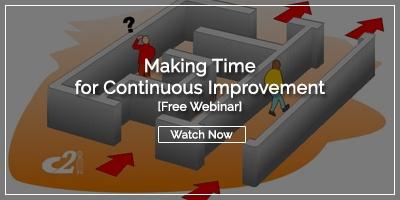 I’ve been sitting here for five minutes debating with myself over whether to title this blog “Common Conceptions that Hinder Continuous Process Improvement” or “Common Misconceptions that Hinder Continuous Process Improvement.” I decided to go with “conceptions” because I don’t know whether these frequently held beliefs are accurate or not within your organization. We do know from countless conversations with our customers that they are devastating to a culture of improvement whether they are true or not. Here’s how you can combat them in either case.
I’ve been sitting here for five minutes debating with myself over whether to title this blog “Common Conceptions that Hinder Continuous Process Improvement” or “Common Misconceptions that Hinder Continuous Process Improvement.” I decided to go with “conceptions” because I don’t know whether these frequently held beliefs are accurate or not within your organization. We do know from countless conversations with our customers that they are devastating to a culture of improvement whether they are true or not. Here’s how you can combat them in either case.
“That’s Not My Job.”
Of course, everyone in the organization has a defined role and set of responsibilities. Most of each person’s time and attention should be focused on their core function, but that doesn’t mean that they shouldn’t be expected contribute beyond that scope. No one, for example, should ignore an urgent safety situation and everyone should be held accountable for participating in improvement work.
How do you overcome this notion? With both recognition and ownership. People who go beyond the bounds of their usual role to solve problems and achieve continuous process improvements should be widely recognized and perhaps even rewarded. It is also a good idea to make process improvement one of the elements that get considered when employee performance is evaluated.
Listen to this Post or Subscribe to the Podcast:
“I Just Do What I’m Told.”
We do want employees who will perform each task according to the Standard work, but automatons are not contributors to continuous process improvement. Just doing the same thing, the same way all of the time is also not ideal for personal development and job satisfaction.
Overcoming this attitude requires the people who do the task be involved in creating the Standard and in each cycle to improve it. The goal is to foster a feeling of ownership over the process and its documentation. Managers and subject matter experts can be involved, but the Standard work should never be simply an edict from on high.
“I’m Just a Worker, No One Values My Opinion.”
Employee ideas can benefit businesses in small ways and big ones. Continuous process improvement is hindered by the waste of human potential whenever employees keep silent. If employee ideas are unwelcome or ignored, leaders should expect to get far fewer of them.
To combat this, managers should encourage employees to share their ideas for improvement and give them a platform for doing so. People should be directly asked what could be done to make their jobs easier and improve results. Gemba walks are an ideal time for having these conversations. It is also important to broadcast success and let people know when ideas from employees are implemented. This is how improvement culture spreads within organizations.
“I Don’t Have Time to Work on Improving Processes.”
These days, people at every level of organizations are often tasked with doing more with less. Often people are fighting to get the same results with fewer people or resources, so it is understandable that time is a major pressure. But continuous process improvement should help ease the burden on employees by eliminating unnecessary tasks and streamlining work. It may be difficult to go through a 5S review, for example, but the resulting improvements should remove friction in the workspace.
There are a couple of ways to make time for process improvement. One is to schedule a rapid improvement event (also called a Kaizen event), in which team members spend 100% of their time, usually over a three to five-day period, focused on perfecting a particular process or getting to the heart of a persistent or urgent problem. Another approach which can be used in addition to improvement events is daily continuous improvement. Small, incremental changes that don’t require a ton of analysis are made on a regular basis without disruption. They don’t require a lot of time but can add up to make a big difference.
For more ideas on how to make time for improvement, check out this webinar:
“I Don’t Know How to Participate in Improvement.”
You’d be surprised at how often this one comes up. Employees might see a problem and know that the process could be better, but they are unsure about exactly how to go about fixing it. Often, they feel that it is not OK to report a problem without a suggested solution, so they just keep mum.
In a culture of continuous improvement, identifying the issue is something to be praised in its own right. Employees are then armed with tools and techniques to execute on the selected improvements. They should be trained in how to use techniques like PDSA, DMAIC, and the 5-whys. Improvement software also helps create a foundation for this work.
We don’t think that many employees opt out of process improvement because they are lazy or not creative. Far more often, culture and training are not aligned with enthusiastic participation in improvement work. It pays to combat these destructive perceptions with every method possible.



Add a Comment